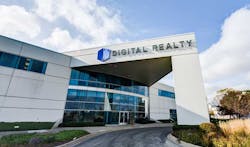Disruptive Technology: Enabling Digital Transformation
In this edition of Voices of the Industry, Sherri Liebo, Senior Vice President, Marketing, at Digital Realty explores how disruptive technology is pushing digital transformation in today’s markets.
Sherri Liebo, Senior Vice President, Marketing, Digital Realty
The invention of electric light made everything about our world extremely apparent, highlighting both the beauty and the flaws in our surroundings. It changed us: Socially. Culturally. Economically. And even biologically—turning us into worker bees.
The invention of disruptive technology does much the same thing. It illuminates the weaknesses in our IT strategies and old-school business models, to which we’ve become accustomed like comfortable warm blankets.
Technology has always pushed us out of our comfort zones—and made us face our fear of the unknown. Though, however painstaking our evolution, it has ultimately driven personal and professional growth and changed the way we think, as well as the way we do business—for the better.
This new era of digital disruption has made digital transformation (DX) a hot topic—again. While not a new concept or term, much like our technology landscape, it’s meaning has changed a lot in the past few years. It seems not long ago “going digital” meant scanning your documents into PDFs, making your abundance of enterprise data somewhat searchable and setting up a website to serve basically as an online brochure.
[clickToTweet tweet=”Sherri Liebo – This new era of digital disruption has made digital transformation (DX) a hot topic—again. ” quote=”Sherri Liebo – This new era of digital disruption has made digital transformation (DX) a hot topic—again. “]
In a nutshell, transformation was intended to make IT departments more productive and cost effective, while enabling faster time to market. These goals still exist across enterprises today. Though this time around the stakes are much higher because we’re solidly into an era of technological disruption, which makes it seem almost impossible for traditional IT strategies or business models to attain the targeted objectives.
Digital disruption refers to changes enabled by digital technologies that occur at a pace and magnitude that disrupt established ways of value creation, social interactions, doing business and more generally our thinking. Digital Disruption can be seen as both a threat and an opportunity according to the Digital Disruption Research Group.
The key words in that definition are “pace,” technologies needs are changing too fast for enterprise infrastructure to keep up, “magnitude,” the impact it’s having on most companies is pulling their focus from doing business to constantly fixing IT or searching for new solutions, and “established ways.” Just to survive in the era of disruption a future-looking approach to IT that can enable flexibility, agility and security, has quickly become the norm.
Today, only one in five organization has aligned its network strategies with its digital transformation strategies. Though, companies with that type of alignment have more than double the rate of revenue growth, customer retention and profit growth. Simply put, DX is the approach by which enterprises drive change across their business models and ecosystems by leveraging digital competencies, per IDC.
Enter the Era of Hybrid Multi-Cloud Solutions
As enterprises take their first steps toward digital transformation, many are adopting hybrid cloud as an enabling solution. An effective hybrid multi-cloud solution can help them bridge the gap between what their existing networks can support and the computing resources they need going forward. A hybrid solution can also almost instantaneously transform their networks and broaden their digital capabilities by giving them the ability to move critical workloads faster and easier, and enabling them to support a suite of hybrid cloud apps. Though, to create the optimal hybrid multi-cloud architecture, you need to first create the right network.
In today’s enterprise environment, a variety of networking challenges, many of them integration related, are keeping many hybrid strategies from succeeding. Pulling together all the critical data center, network and cloud elements into one environment, without amassing numerous vendors and contracts is still a major hurdle for most enterprises. So many IT leaders are still in search of a comprehensive solution that can alleviate some of the obstacles in cloud adoption and make it easier to transform their networks.
Digital disruption and the advent of disruptive technology have made us more competitive, but realizing the potential in technology has also made us more ambitious. Our goal is to help you realize some of those digital ambitions by empowering you to be a true business enabler with a truly future-proof IT strategy.
Digital Realty’s Service Exchange, powered by Megaport, enables the development of a hybrid multi-cloud strategy by offering a faster, easier and better way to connect to multiple clouds in multiple regions and manage your critical workloads and computing resources. Now you can use one physical Ethernet port to securely access all the critical data center capabilities in scale, colocation, and networking within a single, secure environment.
If you’re looking to enable digital transformation, learn more about how the Digital Realty Service Exchange can help you start building your high-performance network today.
Sherri Liebo is Senior Vice President, Marketing, at Digital Realty.

